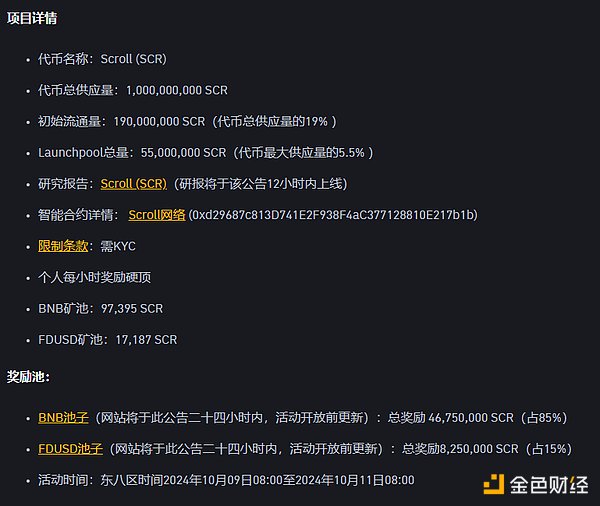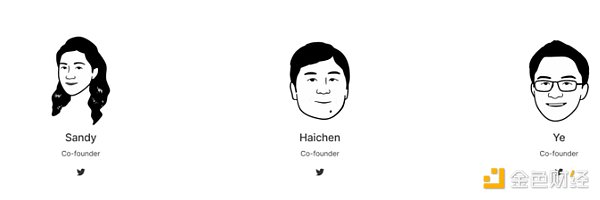Compiled by: Shan Ouba, Golden Finance Source: Golden Finance, Binance, Scroll White Paper, Scroll Official Website
On October 8, 2024, Binance announced that Binance Launchpool launched the 60th project - Scroll (SCR), a bytecode-compatible zkEVM Rollup. Users can invest BNB and FDUSD into the SCR reward pool on the Launchpool website after 08:00 on October 9, 2024 (Eastern Time Zone 8) to obtain SCR. The SCR activity will last for a total of 2 days. The website is expected to be updated within approximately 24 hours of this announcement and before the event opens.
Pre-Market Trading
Binance Pre-Market Tradingwill list Scroll (SCR) and open the SCR/USDT trading market at 18:00 (ET) on October 11, 2024.The end time of pre-market trading and the time of spot listing will be announced later, so please stay tuned for announcements. Eligibility for participating in Binance pre-market trading depends on the country or region where the user resides.
1. Launchpool Details
Token Name: Scroll (SCR)
Total Token Supply: 1,000,000,000 SCR
Initial Circulation: 190,000,000 SCR (19% of the total token supply)
Launchpool Total: 55,000,000 SCR (5.5% of the maximum token supply)
Smart Contract Details: Scroll Network (0xd29687c813D741E2F938F4aC377128810E217b1b)
2. Introduction to Scroll (SCR)
Scroll is a layer 2 scaling solution for Ethereum that leverages zero-knowledge rollup (zk-rollup) to improve scalability and reduce transaction costs while maintaining security and decentralization. This white paper outlines its architectural design and technical specifications, emphasizing its role in the Ethereum ecosystem and its potential to transform decentralized applications (dApps) by providing a more efficient and scalable infrastructure.
Since its inception in 2015, Ethereum has seen a significant increase in user activity, resulting in network congestion, high transaction fees, and slow transaction times. These scalability issues arise from the trade-offs made when prioritizing security and decentralization. Various layer 2 solutions have been proposed and implemented to address these issues, among which ZK rollup has emerged as a superior solution due to its ability to improve scalability without compromising security and without introducing additional trust assumptions for users.
Scroll leverages zkEVM technology to provide a scalable, secure, and efficient rollup solution. By integrating advanced zk proof systems and optimizing hardware performance, Scroll is positioned to solve Ethereum's scalability challenges while maintaining compatibility with the broader Ethereum ecosystem.
3. How Scroll Works
At the core, Scroll operates through a seamless multi-layer system. Its settlement layer acts as a bridge between Ethereum and Scroll, ensuring data availability and ordering on L2, as well as verifying zkEVM validity proofs.
Working in sync with this system is the ordering layer, which is responsible for executing transactions. It combines the efforts of the execution node, which processes transactions sent to Scroll, and the Rollup node, which organizes these transactions into batches and publishes them to Ethereum to ensure data availability. In addition, the Rollup node submits validity proofs to Ethereum, which is essential for the finality of transactions.
Complementing these layers is the proof layer, which is specifically used to generate zkEVM validity proofs to ensure the correctness of L2 transactions. This layer includes a group of provers and a coordinator who not only generates these proofs, but also sends them to the Ethereum blockchain for final confirmation.
Fourth, Scroll (SCR) Token Economics
According to the Binance announcement, the total supply of Scroll (SCR) tokens is 1 billion, and the initial circulation supply is 190 million (19% of the total supply). Scroll's smart contracts will be deployed on the Scroll network. The total reward of Launchpool is 55 million SCR, accounting for 5.5% of the total token supply. Among them, 85% of the rewards (46.75 million SCR) are allocated to the BNB pool, and 15% of the rewards (8.25 million SCR) are allocated to the FDUSD pool.

V. Team Background
Scroll was founded in early 2021 by Ye Zhang, Sandy Peng and Haichen Shen.

Zhang Ye studied undergraduate at Peking University and has been working on ZK proof since 2018. He mainly studies the hardware acceleration of zk proof and the principles of zk cryptographic algorithms. His doctoral studies were also in the zk direction. After learning that the inefficiency of ZK-proof can be solved at the cryptography and hardware levels, he met two other co-founders in the Ethereum community in early 2021. The three decided to use ZK technology to build the future of Ethereum expansion.
Haichen studied at Tsinghua University Yao Class for undergraduate and received his Ph.D. from the University of Washington. His research direction is biased towards the field of underlying systems. After graduation, he worked at Amazon to build machine learning systems and other aspects. He has strong engineering capabilities and is good at putting theory into practice.
Sandy graduated from Cambridge University and worked in research at the Hong Kong Securities Regulatory Commission. In 2017, he began to get involved in the field of Web3 project investment. He also worked on game and product projects before. He is currently responsible for non-technical work in the team and is familiar with the brand operation of the startup team.

Scroll attaches great importance to technical foundations. In 2022, the team size will be more than 40 people, of which more than 30 are ZK or blockchain researchers and developers. It can be said that the entire team is currently quite technical, and there are relatively few non-technical members responsible for ecological operations.
In addition, the team is also relatively "decentralized", with members scattered around the world including China, the United States, Singapore, Europe, etc.
 JinseFinance
JinseFinance






